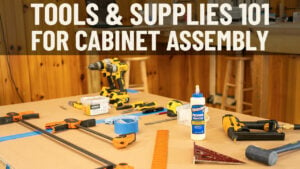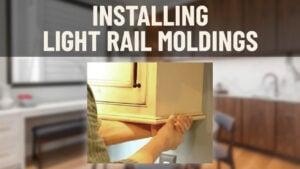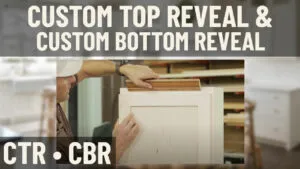Video Transcript
[Music] Hey everybody, Brian from the Cabinet Joint here. Today we're not talking about the cabinets behind me, I'm just going to use them as a prop. What we're really talking about is light rails, specifically our 2670 and 2671 Shaker Light Rail moldings. So let me give you some background on light rail. What it's intended to do is when you have a row of wall cabinets, it's just meant to dress up the bottom of the wall cabinet like that. And traditionally, they've been pretty ornate, kind of some heavily molded pieces. And with the prevalence of Shaker style Cabinetry, very clean-lined, not a lot of Fanfare to them, we needed a Shaker style light rail that would really accentuate these inset and overlay jobs that have really simple door styles. So we set out to do that, we came up with two of them. One is called the 2670, that's the molding number you would order, 2670, and it's for overlay Cabinetry. And then the same version of that molding for inset is the 2671. We'll put a cross-section up of the molding and I want to talk a little bit about its specifications and then show you some uses for it.
The 2670, the overlay version, it's an inch and 3/4 wide, the nose, the front that you'd actually see, is 3/4 of an inch high, a little step that wraps around the front frame is a quarter of an inch, and then you have a 1/8 inch thickness at the base that would get nailed into the bottom or screwed into the bottom of the front frame itself. So what you see is the 3/4 thickness, and both profiles, the 2670 and the 71, just have a really nice eased edge, so it's not sharp. The reason there's one for overlay and one for inset is the overlay one, the nose protrudes 7/8 of an inch, on the inset one, it's only a quarter of an inch. And you'll see that in the diagrams we're going to put up here on the video for you. The reason that is, is because on overlay, the door is going to sit on the front frame and we want the front of that molding to be pretty much level with or in the same plane as the front of the 3/4 inch thick door with its 1/8 inch thick door bumper. So the door is going to actually be sticking off the front frame by 7/8 of an inch. So that protrusion on the overlay version, 2670, is 7/8 of an inch. On the inset one, all we want to do, and this is inset here, all we want to do is just give you a little bit of a detail to dress up the bottom of that wall cabinet. So this goes on like any other light rail molding, no difference in the installation. I won't get into installation here, I'm just talking about the benefits of this molding when you're doing a Shaker style.
Now, the other way this molding can be used is as a separator molding. With these really high tall ceilings we're seeing in kitchens these days, folks are doing a lot of stacking of cabinets. So we have a base run of wall cabinets, like a lower run of wall cabinets, and then stack more cabinets on top. And what that creates, slide this back, and again, these cabinets are not meant to go on top of each other, I just grabbed two cabinets from a job we're doing here in our shop in Gettysburg. What you end up with is a seam where the two cabinets come together and this will act as a way to decorate or dress up that seam. So just do this real quick, if you use this on top of your lower run of wall cabinets and then set your upper wall run between, this acts as a really nice way to dress up that seam and actually becomes a detail or a design element instead of making the seam with the cabinets joint look like a mistake. And trust me, on a white painted or light painted kitchen, you're going to see that seam where those cabinets join. It's a black line, you're going to really distinguish that from the upper and lower boxes. This gives you a great way to decorate that seam and make it look like a design element.
So couple uses for that light rail. Make sure you talk to your cabinet coach about it if you want to use this in your design or talk to your designer if you're working with one of our designers. And I really would encourage you if you're doing a Shaker style or Arts and Craft Style Kitchen, stay away from our B11 molding or any of the real ornate ones. They just don't do these simple doors Justice. This is the molding you're going to want to use. Hope this helps, talk to a cabinet coach if you have any questions. Thanks for watching, take care. [Music]




